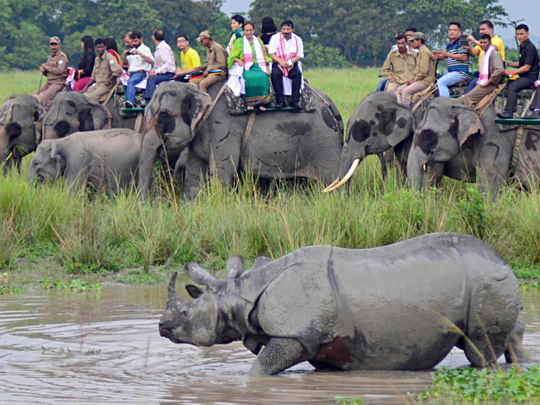
We were a group of 16 family and friends who decided to visit a part of India many Indians are not familiar with. My family had roots in one of these northeastern states and going “home” after a long time, a span of decades for some of us, was looked forward to eagerly.
Our journey began in Assam with a two-day stay in a beautiful resort near the famous Kaziranga National Park. An elephant safari early in the morning enabled us to come close to the magnificent rhino, safely perched on the mammoth jumbo. The mahout steered the elephant towards the rhinos, which stopped to stare at us, wondering if the sight was worth a confrontation. However, seeing the number of elephants coming in their direction, they decided to play it safe and retreated. The hour-long safari yielded glimpses of a variety of exotic birds and trees used as scratching posts by tigers. The latter remained elusive and decided we weren’t important enough to be honoured by their presence.
Our next stop was Shillong, my mother’s home. We stopped at Umiam Lake, a scenic reservoir, before proceeding to our hotel in the heart of the city. It was surrounded by shops and roadside food stalls, mostly run by women. We were soon out in the streets, getting a feel of the pulse of the city. The women in our group started shopping right away, attracted by the beautifully woven shawls and bags.
My family members contacted our cousins and meetings were arranged. We had a lovely lunch at a cousin’s house where we felt completely at home. The animated conversation made a mockery of the years we had been apart as we picked up the threads effortlessly and filled the gaps.
A visit to the living root bridge was one of the highlights of our stay. There are several of these and the one we headed to was close to the cleanest village in Asia, Mawlynnong. These bridges are handmade from the aerial roots of the rubber fig tree. This bridge is about 180 years old and built over the Thylong river. We had to climb around 450 steps to reach the bridge, but it was a sight so breathtaking that the descent and ascent thereafter was well worth it. This is an excellent example of sustainable living architecture.
The sacred grove or forest is a protected area situated in the East Khasi Hills, spread over 78 hectares. The locals believe it is protected by a deity, Labasa. Our guide laid down the ground rules before we entered this area. Nothing must be taken out of this forest, not even a leaf. Respect for Nature is deeply ingrained in the locals as was evident from the passion with which our guide described the symbiotic relationship between Man and his surroundings. There were monoliths scattered throughout and trees which are said to contain a cure for diseases, including breast cancer. One of the trees was a 380-year old pine tree.
We wriggled our way through the narrow rugged limestone Mawsmai cave, overcoming our fear of claustrophobia and subterranean places. It is one of the few caves one can explore without a guide.
The Don Boscoe museum provides a glimpse of the rich, multi-cultural lifestyles of the indigenous people of the northeast. It is Asia’s largest museum specialising in this region and is a seven-storey building very impressively laid out. We could have spent all day there, but other delights awaited us such as Cherrapunji, once the wettest place in the world, and a boat ride on the Dawki river, close to the Indo-Bangladesh border.
We made many unscheduled stops to take photos of waterfalls and the picturesque hills and found that six days was too short a time to get our fill of this wonderland. We would be back, sooner rather than later, we promised ourselves.
Vanaja Rao is a freelance writer based in Hyderabad, India.










